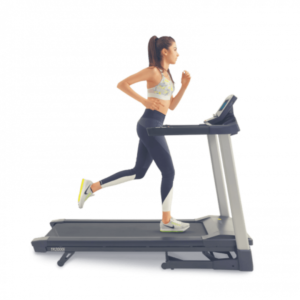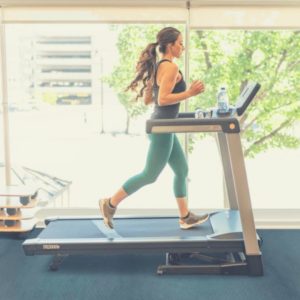Many of us haven’t been to the gym in a while.
If you’re ready to leave the couch behind and build strength and endurance but don’t know where to start, carefully review your daily activities to see where you could move more.
Then add in resistance.
Stay Logical
Losing weight may be a goal, but starving yourself is the wrong path.
Toned arms may be a goal, but hitting yourself in the face with a weight because you went too big, too fast is the wrong path.
Think logically.
If you have a regular walking routine in the morning, add an evening walk. Make exercise fun and relaxing, then build in the training to increase your endurance.
Regular Movement, Scheduled and Unscheduled
Build on what you’re doing.
If your morning walk is 1/2 a mile, can you go 3/4 if you speed walk or jog for part of it?
You can build muscle and more endurance in the same amount of time.
If you normally take a walk on your lunch break, can you shorten the walk and take the stairs for at least part of your return to your workspace?
Stairs are great for building endurance because you’re using the resistance of your body vs. gravity.
While running errands, park as far from the door as you can. It will make getting out of the parking lot easier and you can enjoy some unscheduled exercise.
To increase your load, carry your bags back to the car instead of pushing the cart out to your vehicle. Add a bicep curl or two.
Interval Training Boosts
You can boost your stamina by adding interval training to your current exercise program.
For example, if you currently walk, count your steps and add jogging to the pattern. Walk 100 steps, jog for 50. Repeat this for the first half of your walk, then just walk the rest of the path so you can cool down.
Make sure that any added exercise is paired with added cooldown and stretching. Moving from walking to jogging can cause an increase in joint pain or muscle soreness the next day, so be sure to stretch deeply after your interval training session.
As your endurance builds and soreness decreases, shift to 75 steps each, then flip it and take 50 walking steps and 100 jogging steps.
If you’re jogging already, add intervals of sprinting in the same manner. The best way to boost your stamina with your existing exercise plan is to increase the intensity of the workout.
Keep At It
The American Heart Association recommends 30 minutes of moderate exercise a day to protect your heart.
If you want to build better than average endurance, you’ll need to strive to beat that on a daily basis.
Even if you save your big workouts for the weekends, because you’ll have time for a class or to hit the weights, make sure that you do something each day.
If the weather is terrible, walk the stairs in your home or office for 10 minutes 3 times a day. Find a stretch of wall and do 20 plank push-ups every time you use the bathroom.
Incorporate activity into your other routines. Before you shower, make sure you plank for 30 seconds, or do 50 ab crunches.
You don’t need a home gym to build endurance and improve your strength. A bit of carpet and a little time can work as well as a mat.
Bored, Bored, Bored
If you’re bored with your current workout, find a workout buddy or seek the help of a personal trainer. One or two sessions with someone who can help you use the right form can make lifting weights, doing lunges and core workouts much more interesting.
Also, consider changing up your workout pattern. If you’ve always started with cardio, do a quick warmup and move to weights.
For those who love to walk, add lunges in the middle of the block to get your quads and glutes engaged.
Stop at a park bench and do some plank pushups or tricep dips. Increase your physical endurance by changing up your pattern.
Old Injuries
If you have had to cut back on exercise because of an old injury, make sure you talk to your doctor before trying new activities.
For example, if you had to have surgery to repair damage to a knee or a hip, you may be better off working out in the water until you’re sure the joint can tolerate the pressure and impact of speed walking or jogging.
For those with back problems, discuss your exercise needs with a physical therapist or your chiropractor.
There are many forms of exercise that can be modified to allow you to work around a bulging disc or other old injury.
If you are cleared to take a yoga class, let your instructor know. If they don’t offer modifications, find a new instructor.
You are the primary guardian of your health, so monitor how you’re feeling and stop if things get too painful or intense.
Stand When Possible
A simple way to improve your endurance is to stand when possible. You can take this one step further and drag out that treadmill at home.
Want to watch your favorite TV program? Go ahead, but do it while walking on the treadmill.
Checking out youtube videos? Put down the phone after every video and stand on one leg, in tree pose if possible, for a minute between each video.
If that’s easy, pulse up and down on your toes while you watch. This will strengthen your feet and calves, as well as engage your core.
Physical endurance training will also require you to build up a stable core and great balance.
Prep For Your Day
Always wear or carry comfortable shoes.
If your excuse about walking the stairs is that it’s dangerous in heels, stash some sneakers under your desk.
Invest in some shoe spray to avoid odor (you want to be a good neighbor, after all) and slip out of your office shoes on your breaks.
Do your best to reach a strong stride when working out in the middle of the work day.
No, you don’t want to get sweaty while you’re dressed in business clothes, but you can fully engage the muscles in your legs, core and bottom with long, firm strides.
See how far you can stretch your stride during your lunch walk. Feel it in your glutes.
Stride down the length of your foot and curl your toes as you move to the other foot.
Engaging your muscles from your hips to your toes is a great way to build physical endurance.
Tailor Your Workout

Exhaustion is not your goal. You want to feel energized at the end of your workout, not wiped out.
If you hate to sweat, you won’t keep up on an exercise program that pushes you that far, so build one that doesn’t.
Physical endurance is about building the tolerance to exercise without getting overheated or completely out of breath.
You may not want to be a mountaineer, but you want to be able to climb a hill without needing a rest. You may not be striving to win the yellow jersey, but you do want to be able to bicycle with your kids and not be completely wiped out at the end.
Interval training, which includes both a warmup and a cool down, can get you there without causing you to be completely out of air or covered in sweat.
Get on the Floor

If you have kids or pets, they will love the fact that you’re on the floor with them.
While you’re there, up your physical endurance with planks. If your back won’t tolerate a regular plank, work from your knees.
If this is still uncomfortable, widen your knees to take the pressure off your low back.
Get on all fours and lower your bottom to your feet. Stretch your hands out in front of your head and lower your forehead to the floor.
This is a great way to stretch your upper back, especially if you’re on the computer a lot. Move back to all fours and raise one heel to the ceiling.
If your back feels good, extend the foot straight behind you and hold it until you feel it in your glute.
Core strength will increase your balance, and the stronger your balance is, the longer you can walk, hike and jog.
Gear Up
If you’re thinking about weight lifting as a form of exercise, go to the gym.
Weights can be a big investment, both in time, space and energy. However, you will need really good shoes, at least one water bottle, and a hat if you’re working out during the day.
Don’t skimp on this. Old shoes do more than smell bad. Poorly fitting shoes can cause blistering, which will keep you off the walking path.
If your shoes are too loose, you can twist an ankle or a knee. Tight shoes can alter your stride or cause you to stay on the sides of your feet, which can mess with your hips and your low back.
Visit an athletic store in person. Buy your shoes at the end of day when your feet are at their puffiest. Make sure the toe box has plenty of room.
Use Your Body Weight
Your own body is a great source of resistance, which is key to building endurance.
Planks, crunches, and other ab exercises are great for boosting your overall strength and take nothing more than floor.
Walking and jogging, especially intervallic training, only need a path or a bit of sidewalk. Stairs can be climbed for endurance, and to boost your intervallic pressure, take them faster or two at a time.
Do your best to get out of your house whenever possible. Make your exercise program a habit that actually leaves you feeling unwell if you skip it.
When you know that you need that walk, jog or sprint, you’re on your way to greater endurance and strength.
Managing Your Risks
Many of us are working on our endurance in spite of current health challenges.
Your cardiologist may have been trying to talk you into an exercise plan for years now. Let them know that you’re not only exercising, but working on endurance.
Find out your suggested target heart rate and invest in a tracker to help you manage that goal.
If you are diabetic or are at risk for diabetes
- discuss your workout plans with your doctor and podiatrist. Get shoes recommendations is possible
- buy shoes that will wrap your foot to reduce friction
- invest in moisture-wicking socks
- carefully examine your feet after your workout for any redness
- talk to your podiatrist about ways to protect your skin
If you can’t look at your own feet, prop them up in front of a mirror so you can study the bottoms.
Diabetes hits your feet in multiple ways. You may not be able to feel them, due to neuropathy, and they may break down due to poor circulation.
Rest

If you have a hard workout, struggle with muscle soreness, or feel dehydrated, rest.
Skip the jogging and just walk.
Take a slow cycle around the park instead of hitting the trails. Avoid the cross-trainer and go for a slow jog in the deep end of the pool.
If you get overheated, just dunk yourself and walk for a bit.
Too often, exercise programs fail because we overdo it. Diets fail because we starve ourselves and give up.
If you feel highly energized, go ahead and act on it. Push yourself. It will be fun. However, if you feel exhausted, honor that too.
Final Thoughts
Current world conditions have led to a lot of stress in our daily lives. You may be stuck at home, not able to get out as much as you like, or working more than ever.
Stress often leads to poor behavioral and food choices. Choosing to exercise can both reduce your physical stress response and build strength.
Focusing on endurance training by building core strength and adding interval training can actually leave you feeling better after a workout than you did before you stepped outside.



